#walpole did it
Note
Hello!
On Critical Role's Beacon, there's a series called Abridged and I was wondering if the (official?) portraits that have been incorporated in the videos of Ariks Eshteross and The Nightmare King were your creation or not?
It does look like your style, but I just wanted to be sure.
I believe so! I haven’t laid eyes on the Nightmare King yet, but I did draw a character bible for him and Ariks Eshteross, and I have seen and confirmed the Eshteross one.
A quick point that I haven’t seen anywhere- I designed and illustrated Eshteross, but I only illustrated Ira Wendagoth. He was designed by Tyler Walpole. Tyler does a lot of villain and monster work for Matt so that minis can be made. So the design was fully done and approved before I got to that one. I’ve never met Tyler, but I’m a huge fan and he seems cool as fuck.

Also YES I referenced the Leyendecker smoking jacket. I did it MONTHS, possibly a year before the new Interview with the Vampire came out lololol
Great minds think alike!
#my art#critical role#official art#asks#character design#ariks eshteross#ira wendagoth#nightmare king
240 notes
·
View notes
Text

Drew a few of the @extracreditsblog designs of historical figures they've covered with my own spin on the art style! If you're unfamiliar with who these people are, (top left clockwise order) they're Sir Robert Walpole, Mary Seacole, Vlad the Impaler, Cleopatra, Hypatia of Alexandria (one of their most recent series too!), and Ned Kelly! (aka my favorite out of this lot, and admittedly, of all time! ^_^) I drew them all doing some random poses I deemed fitting for each person, so I hope you all like them! My favorite part was the tiny backgrounds behind each historical figure, it really wraps everything up in a nice bow for each person. My main inspiration was also some Extra History fanart I've seen while scrounging Tumblr, which is why I did the lineup style! Anyways, rambling aside, that's all, I hope you all like this art! ^_^
#extra history#extrahistory#eh#art#fanart#digital art#my art#artwork#history#my fanart#artists on tumblr#literally my comfort channel ever...#they make me so happy#not even kidding#live laugh love extra history#i genuinely appreciate this channel's existence so much#extra credits#extracredits#ec#history art#history fanart#illustration
36 notes
·
View notes
Text
Who Were the "Hessians"?
A good article from Facebook by Dr Alex Burns;
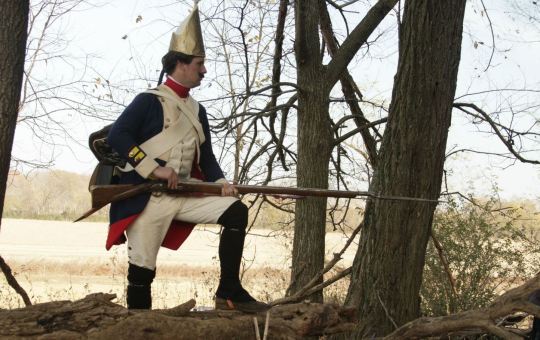
Myth 1): German troops were all Hessians.
Although most came from the mid-sized German state of Hessen-Kassel, troops from six different principalities (Hessen-Kassel, Braunschweig-Wolfenbüttel, Hessen-Hanau, Ansbach-Bayreuth, Waldeck, and Anhalt-Zerbst.) Indeed, the current leading progressive reenactment group portraying these soldiers represents Regiment Prinz Friedrich, essentially a garrison unit from Braunschweig-Wolfenbüttel.
If you include the larger, global war outside America, fought in places like Gibraltar and India, troops from the state of Hanover (Braunschweig-Lüneburg) also fought for the British outside of the Holy Roman Empire (the pre-German territorial entity.) So, while over 60% of these troops came from Hessen, they really hailed from all over the western and central Holy Roman Empire. As a result, it might be better to call them something other than Hessians. "Germanic" has been put forward, but that usually conjures up images of the fall of the Western Roman Empire.
Myth 2): They were mercenaries.
Imagine you are a soldier in the United States Army, serving in West Germany during the Cold War. You are stationed there because of longstanding agreements and alliances, which stretch back decades. The United States Government and the West German government have a financial understanding that helps maintain your presence in the region. Are you a mercenary? The situation was very similar for the German-speaking soldiers who fought in the American War of Independence, They had a longstanding relationship with Great Britain, stretching back decades. They had fought with alongside the British since the 1690s, both in continental Europe and in the British isles. As a result of the Hanoverian succession in 1714 (the British Royal family was drawn from Hanover) they had longstanding marriage connections with Great Britain. Horace Walpole, a British politician from the 1730s, referred to the Hessians as the Triarii of Great Britain.
These soldiers did not personally or corporately take on contracts from the British. they were members of state militaries: their governments were paid a subsidy by the British in order to fight in their wars. Frederick II (the Great) of Prussia, received subsidies from the British during the Seven Years War. As a result, the modern German term for these troops is *Subsidientruppen, *or subsidy troops. **Thus, it might be better to speak of the German-speaking subsidy troops, as opposed to calling them Hessians, or mercenaries. **Historians have argued that it might be fitting to call their countries "mercenary states". This is different from saying they were mercenaries.
Myth 3): They were sold to America because their princes were greedy and wanted to build palaces and pay for their illegitimate children.
The princes of the Western Holy Roman Empire lived in an incredibly dangerous world during the eighteenth century. Their territories were small, rural, principalities, trapped between the military giants of France, Austria, and Prussia. As a result, from the 1670s, these princes attempted to use subsidy contracts to build themselves larger armies, in order to preserve their independence. These subsidy contracts were a standard feature of European politics, diplomacy, and conflict resolution. They allowed the princes to better protect their small domains. None of the princes who formed subsidy contracts with Britain during the American War of Independence were doing something radically new or greedy. Instead, they were following on decades of practice which had allowed them to maintain their own independence. The Hessian (Hessen-Kassel) Landgraf Friedrich II actually used the funds from the contract, in part, to promote economic development and the textile industry in his territories. **Some of them had illegitimate children. Some had palaces. Portraying them as sex-crazed misers limits our understanding of the economic and security necessities which actually underpinned their subsidy policies. **Following the long-standing practices of their governments, princes in the Western Holy Roman Empire entered subsidy agreements to maintain the costs of their states.
Myth 4): They committed many brutal war-crimes in America.
The subsidy troops had been used in messy civil conflicts before. Hessian troops were used against the Jacobites in 1745-6, where they remarkably refused to take part in the repression against the Scottish Jacobites. Their troops were remembered in Perthshire, Scotland, as "a gentle race," and their commanding Prince (Friedrich II) declared, "My Hessians and I have been called to fight the enemies of the British crown, but never will we consent to hang or torture in its name." (Duffy, *Best of Enemies, *p. 133). English officers in the Seven Years War, noted that their troops were reprimanded for plundering more than Hessian forces. (Atwood, *The Hessians, *p. 173). In North America during the War of Independence, the Hessians once again behaved better than their British counterparts. Although there was a surge of fear about Hessian brutality early in the war, after the first few years of the war, Americans believed that the Hessians treated them better than British soldiers. Aaron Burr wrote of Hessian atrocities: "Various have been the reports concerning the barbarities committed by the Hessians, most of them [are] incredible and false." (Matthew Davis, *Memoirs of Aaron Burr, *Vol 1. p. 107). Comparing the brutality of the Napoleonic Wars with the American War of Independence, a Hessian veteran who served in both wars commented: "Everything which the author has subsequently seen in this regard greatly exceeds what one should term cruelty in America, which in comparison with more recent times, can be regarded as nothing more than a harmless puppet show." (Adam Ludwig von Ochs, *Betrachtungen Ueber die Kriegkunst, *60-61.) Hessian troops committed crimes in America, there is no doubt. What is clear is that these crimes were not excessive for an eighteenth-century conflict.
Myth 5): Many of them deserted to America, where life was better.
Many Americans claim Hessian ancestry. As a result, it is common to encounter the sentiment that these "mercenary" troops were simply waiting to switch sides. In reality, most of these troops returned to their homelands in the Holy Roman Empire. A very small number switched sides before the end of the war, a larger (but still small) percentage elected to remain in America after the war ended in 1783. Far from being an act of rebellion, the princes encouraged their subsidy troops to remain in America if they desire: this would cut costs, and make the process of slashing the military budget easier in peacetime. Most returned to celebrations, public parades, and being welcomed by loved ones. For more on exact data of desertions, as well as the subsidy-troops' return home, see Daniel Krebs' book, *A Generous and Merciful Enemy. *The majority of these troops remained loyal to their princes, and returned home to their own native lands.
Who Were the Hessians?
The experience of 37,000 soldiers mainly drawn from six small counties is not all one thing. There are elements of truth to each of the myths about the Hessians, but their story is more complex than the myths that are told about them in English-speaking circles in North America. They were drawn from a fascinating world in Central Europe with its own customs, practices, and traditions. They entered the American story, and as a result, it is worth taking the time to understand and remember their path in it in a complex way.
A "Hessian" Reading List:
Rodney Atwood: "The Hessians: Mercenaries from Hessen-Kassel in the American Revolution"
Friedrike Baer: "Hessians: German Soldiers in the American Revolutionary War"
Stephan Huck: "Soldaten gegen Nordamerika Lebenswelten Braunschweiger Subsidientruppen im amerikanischen Unabhängigkeitskrieg"
Charles Ingrao: "The Hessian Mercenary State: Ideas, Institutions, and Reform under Frederick II, 1760–1785"
Daniel Krebs: "A Generous and Merciful Enemy: Life for German Prisoners of War during the American Revolution"
#history#military history#18th century#american revolution#revwar#american war of independence#hessian#hessians#german
129 notes
·
View notes
Photo

Unlucky Witness
The guard took a midnight shift to earn a promotion. Unfortunately, so did the assassin.
Artist: Tyler Walpole
TCG Player Link
Scryfall Link
EDHREC Link
#mtg#magic the gathering#tcg#$0.07#tyler walpole#unlucky witness#streets of new capenna#creature#human#citizen
26 notes
·
View notes
Text
Summary Notes of Terror Camp 2023 (9.12.23)
(A small summary of notes and references I took during Terror Camp Day One)



Erasure of Sailors of Colour in Arctic Exploration!!! Needs to be explored much more.
JEAMS Fitz-James Fitzjames - w'ont put his apostrophes in the back of words.
Capitalising Letters where you would Not usually capitalise them is like Italics. it is Emphasis in speech when written.
These jokes are getting Auld. (If you know you know)
Most things were phonetically written.
WOAHOO!!!
- James Thompson
Relic? Or Artefact?
Semiophore - Objects regarded in a given community as carries of meaning.
Walpole is a little fucked in opinion. (imo)
Dundy was awful at spelling. Worse than Goodsir.

Capitalists should really look into Thomas Holloway
Everyone knows and loves Snarfin' On Them Ribs Saturday Man Proposes, God Disposes
Lady Jane was offended.
Hudson Bay Speedrun - Let Curiosity be your Compass
James Knight does not girlboss but he thinks he does.
A Ship Called The Whalebone
Roald was both an asshole but good at what he did.
The Raft of the Medusa - We knew where that was going.
Johnathan Miles is a Horse Girl
Foreshadowing of the Cannibalism and Mutiny
HOOSH
History is a Panopticon
They were just people...
(Also a Note. I am worried that a lot of the fandom thinks that the concept of a Panopticon originates from TMA and that it was a TMA reference. It was not. I am wondering now if the TMA listeners know who Jeremy Bentham is.)
Cultural Understandings
IceBound Not Down - I did not take a lot of notes on Professor Hester Blum's panel. I was far too invested to write and when it was over I realised I had not made any notes. She was incredible. I loved her narratives very much. I would love to get her book. It is on my list! You would have had to have been there. It was wonderful.
Not News: Dan Simmons is a wee fuckboy. We have established this a lot. He also establishes this for us.
(?) Umlaqtalik - There is a boat there.
Imperialism is a disease.
How to read Ethically!

Some of my Notes from the Panel with Paul Ready and Nive Nielsen:

"You can hear a smile in a recording" - Nive Nielsen
Paul "I am not an expert on Anything" Ready
He is so very attached to Goodsir. Goodsir is very much a part of him. Hearing him talk about how integrated Goodsir is to himself was wonderful.
"I think we need more Goodsirs in the world."
Nive and her impressive education on the importance of indigenous representation and how that impacted her. How her voice as not only an actor but an Indigenous Actor was taken with such respect and was given the space to allow for respectful and creative extrapolation on the Set.
A small Note in my book that says: Oh goodness me he is hideously beautiful. I cannot stand how beautiful he really is. Oh my goodness.
"Nothing is good or bad. Just the potential to be."
- Nive Nielsen - Terror Camp 2023
Nive: All Humans are good at picking up sincerity.
Goodsir would have hated Hickey.
"Ah. Would you look at that. Dead with my ass carved up."
- Paul Ready
Nive: You cannot kill people or let people die because everything is connected and you do not know how that will effect your future. You have to depend on each other. So when there was conflict you had to solve it with as little violence as possible.
A very Important Book Nive Nielsen had spoken about!
You can get a copy on Thriftbooks of "Give Me My Father's Body" by Kenn Harper Here

I had an incredible amount of fun during this event. I am so excited for tomorrow. What notes you are seeing here are just references to part of the panels and some side comments I had made between all of my other more detailed notes. There was so much to be had and so much that we saw and heard. The speakers were incredible and each individual was incredibly dedicated to their impressive Art and Passion. It truly showed. As Nive said: You can hear a smile in a recording". I feel as if this applies to every one of the speakers and all of the panels we had the pleasure to enjoy today.
I have more detailed notes in my journal which, of course, you can see I scrawled a lot in. I had amassed about seven whole pages worth in that time. So to type them all would be just simple a task I cannot do. But I am open to discussions regarding how everything was if you did not get to attend it! Also Terror Camp has a wonderful setup available for you to explore the other avenues that they have presented on their website. So please do go check that you if you are interested! I cannot wait to do this tomorrow with my fellow Shipmates. Thank you so much for everyone that put together @terrorcamp. I am quite excited for tomorrow!
With much love and saltwater kisses,
Second Leftenant in heart and spirit,
-Wilbur E. F. C.
#nive nielsen#paul ready#the terror amc#the terror#harry goodsir#silna#lady silence#terror camp#terror camp 2023#Thank you so much for this experience!
54 notes
·
View notes
Photo


This mansion in Dover, Massachusetts sold a few years ago for $13.250M. It has 6bds., 8ba. and is on 21.31acres of land, but it also has something that no other mansion we’ve seen has.

It has a lovely entrance hall.

Plus a nice sitting room with a marble fireplace.

There’s also a family room with a rustic stone fireplace.

Of course, it has a formal dining room

And, a chef’s kitchen.

The pantry is nice- I like the blue cabinets and soapstone sink.

Like most big mansions there’s an elevator.

A pretty home office with a kitchenette.


Large main bd. and en-suite.


This bd. has its own library.

Another large bath.

There’s always a work out room.

And, at least a 2nd kitchen.

The home theater has comfy sectional sofa seating.

And, there’s a rec room with a bar.

An extensive wine cellar.

Outdoors is a patio that features a stone fireplace and an outdoor kitchen.

It has a beautiful pool.

And, a cute guest house.

There’s also a barn with farm equipment.

Notice the cows in the field. (Do they convey?)

But, this is what it has that no other mansions have.

A loaded potato shed. Look at this stash! Did they get rich on growing potatoes? At least they’ll never go hungry. I would hope that these convey with the shed.
https://www.realtor.com/realestateandhomes-detail/18-Walpole-St_Dover_MA_02030_M49522-51180
236 notes
·
View notes
Photo

Horatio Gates
Horatio Gates (1727-1806) was an English-born general of the Continental Army during the American Revolutionary War (1775-1783). Initially viewed as a hero for his stunning victory at the Battles of Saratoga, Gates' reputation was later tarnished by both his involvement in the Conway Cabal to replace George Washington as army commander, and his catastrophic defeat at the Battle of Camden.
Early Life & British Service
Horatio Gates was born on 26 July 1727 in Maldon, Essex County, England. He was likely the son of working-class parents Robert and Dorothea Gates; his mother, a housekeeper for the Duke of Bolton, was able to use her position to secure opportunities for her family that otherwise would have been out of reach. For instance, through her friendship with the waiting-maid of the Walpole family, Dorothea Gates managed to get future English writer and politician Horace Walpole (who was 11 years old at the time) to be the godfather of her son. In 1745, 18-year-old Horatio Gates was able to purchase a commission as an ensign in the British Army, largely thanks to the influence of the Duke of Bolton.
The young Ensign Gates has been described by biographers in unflattering terms; one characterized him as a "little ruddy-faced Englishman peering through his thick spectacles" and a "snob of the first water" (quoted in Boatner, 412). He first served with the 20th Regiment of Foot in Germany during the War of Austrian Succession (1740-1748) before volunteering to travel to Halifax, Nova Scotia, to serve under its governor, Edward Cornwallis; Cornwallis was not only an early mentor to Gates but also the uncle of Lord Charles Cornwallis, who would one day face Gates on the battlefield. Promoted to the rank of captain in the 45th Regiment of Foot, Gates saw action against the Mi'kmaq and Acadians in Canada. In 1754, he married Elizabeth Philips, daughter of a Nova Scotia councilman, with whom he would have one son, Robert (b. 1758).
In 1755, as the French and Indian War (1754-1763) was escalating in North America, British General Edward Braddock was sent to lead an expedition to capture the French-held Fort Duquesne and thereby assert British control of the Ohio River Valley. Gates traveled to Fort Cumberland, Maryland, to join the expedition, where he would have met several other men who would one day also play key roles in the American Revolution including Daniel Morgan, Thomas Gage, Charles Lee, and, of course, Lt. Colonel George Washington of the Virginia militia. Braddock's Expedition set out on 29 May 1755 and made it to the Monongahela River a little over a month later, where it was ambushed by French troops and their Indigenous allies. General Braddock was killed in the ambush, and a large portion of his army became casualties including Gates, who was wounded. The survivors retreated to friendly territory.
After the Battle of the Monongahela, Gates was mainly relegated to positions of military administration, something at which he proved exceptionally talented. He served as chief-of-staff first to Brigadier General John Stanwix and then to Stanwix's replacement, Robert Monckton. In 1762, Gates accompanied Monckton in the capture of Martinique. Although Gates did not experience much combat during the expedition, he was nevertheless tasked with bringing news of the victory to England and was rewarded with a promotion to the rank of major. The war ended the following year and Gates returned to England, only to realize he had little future in the British Army; the limitations put on him by his social status meant that he could not advance much further in the military than he already had. Frustrated, Gates sold his major's commission in 1769 and, with assistance from his old army comrade George Washington, moved to Virginia with his family. Gates purchased Traveler's Rest, a Berkeley County plantation next door to Washington's younger brother, Samuel. As Gates began his new life as a Virginian planter, he also purchased several enslaved people to labor in his fields.
Continue reading...
14 notes
·
View notes
Text
Why Do They Talk Like That: a stream of consciousness
Fantasy linguistics are so hard like where do you draw the line... I mean none of my characters are referencing major theistic religions or using real life loanwords or expletives but then there's quote-unquote fun stuff like "sadism" or "lunatic" or "sinister". i.e the Marquis de Sade does not exist in this world, but the concept of pleasure from cruelty does... Latin is not a language there, but I, personally, am writing in English, which has much of its etymology rooted in Latin (as well as pretty much every other language ever), even if there is no hate for left-handed people or indeed the left in this world, so "sinister" is inexplicable in itself now (odd how the left has historically been demonised and that it's also the socialist side of the political spectrum. not that odd really. thank you robert walpole?). The same with "lunatic": the moon is literally worshipped in some areas of my world, but it's still a term characters use, despite the moon having positive connotations.
Where Do You Draw The Line... I can't write in a conlang because a) I am not masochistic but b) I want my work to actually be read. You can imply different languages with accents and word choice and compound words, but ultimately I am writing in the same language for all (despite being bilingual, go me!) and ultimately that language is one that exists only in our world and not in the one that I've created.
While we're here, let's talk about swearing (cursing if you're american?) in fantasy settings. I don't mean "oh my god/s", that's arguably blasphemy and certainly not explicit; I don't mean "bloody" (not really explicit either) because frankly that does tend to fit a fantasy vibe with the type of characters likely to use it (considering the real world stereotypes and thus the archetypes an author will write using it). I mean expletives like "fuck", "bitch", "shit": STOP USING THEM. you absolute buffoons.
Recently I read a fantasy novel which included a whole magic system and several countries with absolute monarchies, etc, and they kept using expletives and it just did not work, and it never does. A step back: I believe that using expletives when writing in a real world setting (provided it's period-believable, of course) can work, and often (not always, not even mostly) works - I do it myself. However, believable expletives and exclamations and intensifiers can and sometimes do make or break worldbuilding, at least for me. The worldbuilding in the novel was fine, good even! But every time the (twenty-eight-year-old) mc used "fucking" or "bitch", I was immediately yanked out of the story and into reality. It was like reading a period piece (say, in the 19th-early 20th century) and seeing "bitch" in the expletive (slur) sense. I don't care whether it would be used: I don't BELIEVE that it would be.
Suspension of disbelief is everything, which (as a theatre kid...) is, I suspect, why musical films don't work: we're primed for a more true-to-life piece, whereas in a theatre, we're prepared to cast a lot more aside. We KNOW they're actors, we know bursting into song is unrealistic, but it's the stage! We believe it anyway. Seeing a fantasy character, particularly one that was meant to be a minor royal, consistently THINK in expletives (and not just exclaim them!) felt to me like watching Mean Girls The Musical The Movie. I did not believe the magic (which was a major plot point so it kind of sucked). I did not believe that the characters saying "bitch" and "fuck" would say those words, especially since those characters were almost exclusively limited to the middle-aged queen, an almost thirty-year-old established to be groomed into mild-mannered obedience, the former queen's guard and a (bastard) prince. I did not believe that the characters whose thoughts I was reading would think them, and thus I did not believe in the story.
If you're going to create a prose-based world intended to be separate from our own in terms of religion/history/sociopolitical structure/magic/etc, you NEED to think about the linguistics. I'm not saying think HARD or be super mega creative: in my sky-worship country, a common exclamation is "stars-be", short for "stars-be-dimmed", ditto "skies-be" and "skies-be-felled". My sun-based little sillies go "be-set" as in "sun-be-set"; the only country in a technological revolution (also the only country with guns): "I'm not wired that way"; "he's gearing for a fight"; "I was shooting for you". Furthermore, when explaining their culture in other languages, they struggle for words, because, for example, a train is a monolingual concept (one falters when about to describe someone as a "train wreck" and just goes "sorry"). It's not clever, it's not particularly original, but, in my opinion, it makes the language, and by extension the world, more believable.
While I'm mid-rant: there's a marked difference between characters of different class and upbringing. My more religious, self-righteous queen of skycountry says "my stars": she rules the country, she is a little crazy insane, she feels that she owns the sky, too. A less-educated character uses slang like "lunar", "feared", "heartfulness" where his posh boy counterpart says "insane", "afraid" and "empathy". And yes, I am totally neurodivergent, and I think about details, and I also study the development of the English language and want to continue to do so at university, so of course I am more drawn to it, but at the end of the day if you're writing prose then the words are really bloody important.
TLDR: worldbuilding is hard; do your high fantasy (or even low fantasy) characters NEED to say "fuck"?
#writing#ocs#worldbuilding#fantasy writing#fantasy worldbuilding#linguistics#or just me being autistic#ven talks about sociolinguistics#surprisingly for the first time#creative writing#writing advice#rant#yeah this is just a rant#the book was kill the queen btw#and it was good despite the fact that being clean would honestly have improved it#this is going to be so valuable when i'm rich and famous#got the capital letters out for this
7 notes
·
View notes
Text
true history: true mystery, chapter 1085 spoilers
OH MY GAWD,
What a chapter. And cos he's my boy, told you we didn't have to worry too much about one

Trafalgar
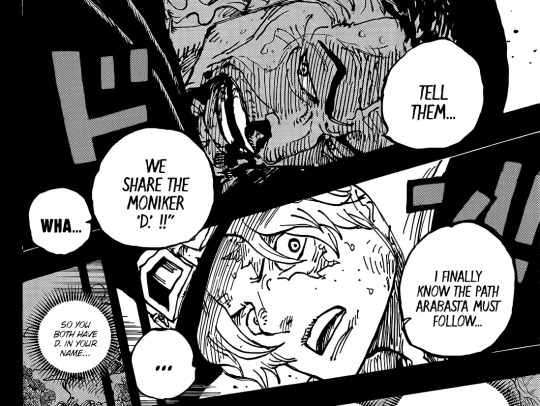
D.

Water Law!
I'm so excited (I feel like I should go out and order the whole set of steak knives).
Anyhoo! I remember when I enjoyed reading the scans on my Friday, and they now come out very early my Thursday morning (like, super early. It's just shy of 3am). BUT this was a treat. And the reason I mostly read them is to prevent being spoiled, but also because they include really interesting translator's notes, etc. such as the ones below about Imu:
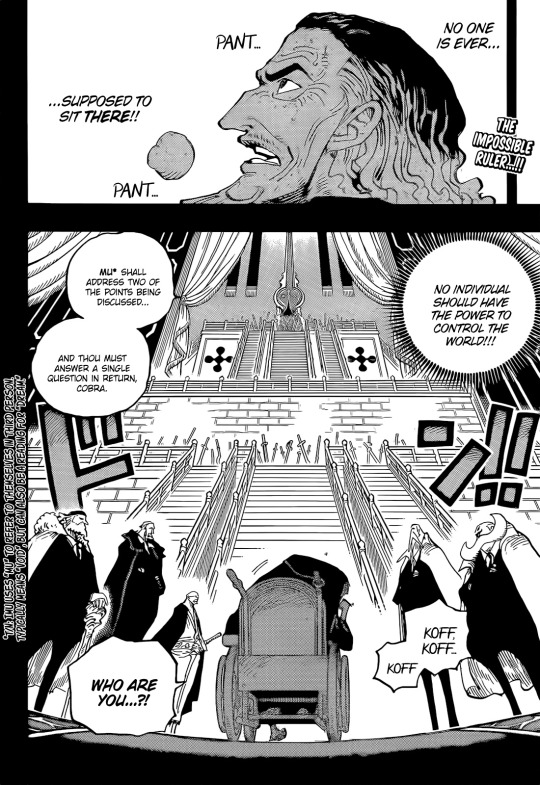
Which is difficult to see, but basically it says that Imu refers to themself as Mu and then says that Mu can refer to the void century but also to dreams. Super interesting. And so, Lili was not, unfortunately Imu (but that's okay, cos' I love this story line too), BUT she was a...

D!!!
As shown above, where King Cobra realises...
...that he won't survive his encounter with Imu (who was apparently one of the original 20), and Cobra reveals that Lili was Queen Nefertari D. Lili. GOOD STUFF. Sabo overhears. Imu has some problems with this, because, as stated by Cora
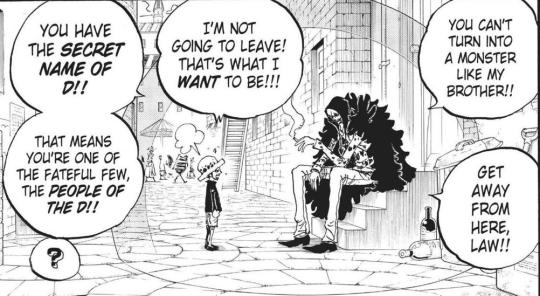
and reiterated by (without knowledge to the best of our understanding) Imu

the "D" is the moniker of the Celestials ancient enemy.
And, although sketchy, look at the perspective from that panel above! Imu is miles above them all. Another aside, while looking up Cora and Doflamingo stuff, there's also the 'heavenly' perspective on this frame with Cora and Law, but I also know Oda is fond of this type of editing/story telling:

Back to 1085: Cobra's recollection that Imu was the name of one of the original 20 does tie into the probable theory that Imu had the eternal youth operation centuries prior.
Anyhoo, this is well out of order (my posting of frames) as always! Sorry. It's not only the D's that Imu and their clan need to be scared of, but also

the scholars. Be still my LawBin shipping (platonic or romantic) heart! But, I digress. So Lili is the one responsible for the preservation and also dispersal of

the poneglyphs. Whole page there. So much information! Cobra has not revealed that Lili was a "D" at this point, or that he himself is, so he was playing with fire coming in to see the Elders, but I guess the whole lineage had known about that for a long time then (that they had the initial for some reason) and had survived. It also seems that maybe King Cobra did know more about the poneglyph in Alabasta than previously assumed. Perhaps?
Anyway, Imu above says that Lili's dispersal of the poneglyphs around the world was perhaps a deliberate action (apparently it had been passed off as a mistake, a blunder) as part of a larger plan. And with the reveal of her being a possessor of the Will of D. it seems it probably was, even if she was a catalyst, as so many D's seem to be, without having full awareness or knowledge of what ultimate role they're playing.

Full page again, cos it's so good. So Imu questions Cobra as to why they never divulged Lili's full name, only referring to her by her royal title, which is actually pretty standard practice. BUT, Imu obviously has very strong convictions that Lili is one of those rabble rousers who get this his entity-self really hot under the collar too!
And the Gorosei basically saying: You can't expose that we're some kind of oligarchy/dictatorship/absolute malignant monarchy when it's supposed to be some kind form of supposed League of Nations acting for all countries and supposed world peace. Interesting mix of Imperialism and colonialism these guys have going on. Anyway! The revery is still going on, and is now absolutely proven to be a farce:
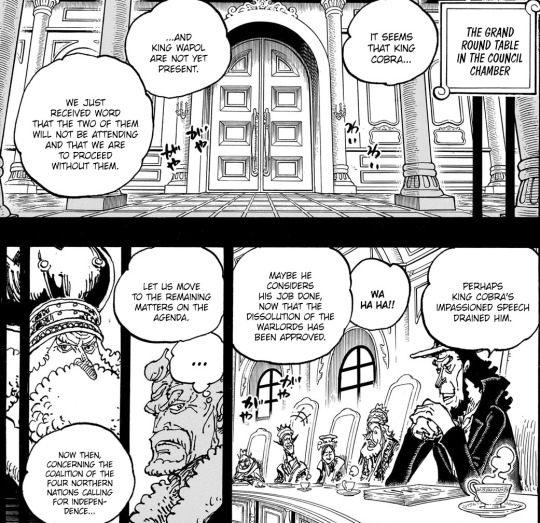
Although King Neptune, and who's the other dude? Can't remember. Not Dalton, is it? (please let me know) King Riku Doldo are looking very skeptical at the Uncle Sam dude. (Thank you @robinchan-hananomi !)
Walpol becomes relevant in a way that it seems that Caribou will be too, and Vivi has been kidnapped by the CIA CP0 (or are they CP9)?
Walpol overhears and sees not only Imu's decimation of Cobra with figures that look a lot like Kanjurou's Kazenbo flame spirit from Wano (did the Gorosei shape-shift too, or was it all Imu sending out some kind of malevolent spirit?), but I think he also overhears Cobra's revelation to Sabo that has a nice SFX bubble over it to just tease we readers enough with hints of information about how the Poneglyphs must be protected, and will seemingly will help usher in the dawn! Ooh, so excited.

BTW. What or who is the figure behind Cobra in the bottom right panel? Sabo?
Walpol outs himself as having seen everything, so shocking is it to him:

and so the spectres are on his tail (and I think it's quite funny that first Imu doesn't know or sense Sabo, and other defenses are breached by Walpol, of all people!). SO, he's one of my least favourite villains, along with Caribou and Spandam, but I'm guessing there's something with their devil fruits that make them crucial to the plot, as well as being kind of incidental characters witnessing key points of One Piece lore.
I doubt he has any great love for Vivi, but he also probably knows where his best chance for survival lies, so, it seems he's been creeping around the castle and I'm going to align CPO with Get Smart now, cos they've got that kinda vibe. Not goofy enough to be Scooby Doo (although Jabra does a good job), but still funny and sexy enough to be the characters of Get Smart who weren't Max. (look it up if you don't know).
Anyhoo! Vivi got kidnapped, and I'm guessing it was at the urging of the gorosei who did it at the urging of Imu, or maybe if Cobra didn't spill the beans, they would've used her as a bargaining chip. Anyway, Kalifa here:

stating that Vivi will end up being a pet (?!?). Did Charloss want her? And I'm wondering if Jabra's wording is a mistranslation, although maybe not. As far as I'm aware, the expression is "play your cards closer to your chest", but maybe it's changed over time. Or there's a pun I'm not getting.
Vivi's reaction in the following frame is awesome (gonna put the whole page in again, cos it's got so much info):

First, awesome that Shirahoshi got away, and we saw that way back when with Garp accompanying the family back to Fishmen Island. Cool info dump from Jabra above. (Very chatty secret agents. Maybe that's why they don't get to wear masks). But I especially like Vivi's incredulity at Kalifa's comment, and her commitment to doing something about it. She's got a devil fruit, doesn't she? Yes! BUT

Trashing young prince to the rescue! (okay, he's a king, once disposed, newly reinstated somewhere) (but he is young. This guy's in his 20s, I think). Vivi hitches a ride with the dumpster on wheels. And from there, Big News Morgans picks them up! (not yet witnessed). Here from chapter 1074:

She's really gone up in my estimation. I never noticed how much she speaks her mind and sticks up for others before (I'm slow, don't worry). And it's not just cos she's a D. Haha. That's not an automatic "like" card, but I might be a little predisposed.
Speaking of which, this part with the ASL brothers was hilarious:

"Do want a "D" in your name, Sabo?"
"You can be Sad. Bo!"
"Why'd you put it there!?!"
Ah, lol, bless.
Also, Imu has the same kind of imperiousness as Doflamingo. Doflamingo's rougher in speech, and I'm guessing with the "thou" and so on shown in the scanlation on the first page that Imu is formal, but as entitled and condescending as fuck, just like our pink feathered friend.
One thing (or many) so interesting about Doffy, though, is:

from chapter 727, is that he's a man very sore about losing his Celestial dragon status, who wants to destroy them and the world government, and who is not afraid of the CD's. Also, it seems that he's well aware of Imu (Mary Geoise's greatest treasure?). I wonder how he was going to challenge Imu if Law had granted him eternal life. If that was his aim. So, a digression, but I think our pink bird will again be relevant soon! Fingers crossed, and I really don't want them to redeem him. Please.
Lastly, the cover was very cute:

Franky directing newly hatched turtles to the ocean, and it's true, so many head in the wrong direction, and such a small proportion actually survive, so he's a hero. Is he sitting on a turtle-hatchling eating crab?
Dunno if any of this was coherent, and I'm sure I missed a bunch, but over and out for now (ah, back to bed!).
#one piece#chapter 1085#king cobra#imu one piece#will of d#poneglyphs one piece#poneglyphs#nefertari vivi#walpol one piece#one piece spoilers#opspoilers#op spoilers#chapter 1085 spoilers#long post#chromanga#chromacaps#chromalami#chromameta
115 notes
·
View notes
Text

Craig Jordan
Pharmacologist whose research into tamoxifen helped many women with breast cancer to live longer
In the 1970s only 40% of women diagnosed with breast cancer could expect to survive for 10 years or more. Today that figure is over 75%. Screening and early diagnosis have played a part, but one of the key reasons for the improvement is the drug tamoxifen, which massively reduces the risk of cancer recurring after surgery.
The British-American pharmacologist Craig Jordan, who has died aged 76, was the first to show that tamoxifen could stop tumours growing by blocking the female hormone oestrogen from locking on to cells in the breast at specific sites called oestrogen receptors.
Breast cancer is the commonest cancer in women across the world and 80% of women with the disease have receptors that make them sensitive to oestrogen, which can stimulate cells in the breast to reproduce uncontrollably and form tumours.
Jordan’s lifelong study of tamoxifen led to the discovery of a range of other effective treatments for breast cancer that either blocked oestrogen receptors or reduced the amount of the hormone the body produces. His studies have also improved women’s health by shedding light on other conditions including endometrial cancer, osteoporosis and menopausal symptoms.
He made his discoveries in the face of huge scepticism from the medical community. He was not a medical doctor but a laboratory scientist who conducted his research on rats and mice. Tamoxifen does not kill cancer cells, it simply stops them from growing. The received wisdom in the 70s when he began his work was that the only way to deal with cancer was to cut it out, or blast it with radiation or powerful chemicals to destroy every trace of the tumour. Such treatments, though they can be effective, are distressing for patients and have many side effects.
“There was an obsession with the idea that that combination chemotherapies were going to cure all cancers,” Jordan told the website Oncology Central in 2019. “It felt like we were trying to swim upstream as we were saying no, target the [o]estrogen receptor and give tamoxifen forever and people will stay alive.”
It took decades before the evidence for tamoxifen’s effectiveness became undeniable. A number of clinical research groups, encouraged by Jordan’s laboratory results, had tested tamoxifen in patients, but the results, though encouraging, were too marginal to change practice.
In 1998 the Early Breast Cancer Triallists Collaborative Group, based in Oxford, combined the data from studies of 37,000 women to show that those with oestrogen-sensitive tumours who took tamoxifen for five years after surgery experienced a 47% reduction in the risk of the cancer returning and a 26% reduction in the risk of dying within 10 years.
Tamoxifen and other selective oestrogen receptor modulators are now part of the standard treatment for women who have had surgery for oestrogen-sensitive breast cancers.
Jordan’s mother, Cynthia Mottram, was a GI bride who met his father, Virgil Johnson, when he was in service as a soldier with the US army in Britain during the second world war. They returned to New Braunfels in Texas, where Jordan was born, but the marriage broke down and she brought her son back to her home in Cheshire when he was a toddler.
He attended Moseley Hall grammar school in Cheadle, where he took to chemistry with such enthusiasm that his mother let him set up a laboratory at home (leading to the kinds of near-disaster that punctuate the early lives of many successful scientists). After his mother remarried, Craig was adopted by his stepfather, Geoffrey Jordan, and took his name.
At first his ambition did not reach beyond working as a technician at the nearby ICI laboratories, but he successfully obtained a place at the University of Leeds to study pharmacology. Taking a summer job with ICI, he met the endocrinologist Arthur Walpole, who had been part of the team that developed tamoxifen, then known as ICI 46,474.
It was supposed to be a contraceptive, but early trials led to more pregnancies, rather than fewer. During his PhD at Leeds, Jordan developed strong links with the ICI scientists, who funded the early stages of his work on oestrogen receptors.
In 1972 Jordan went to the Worcester Foundation for Experimental Biology in Massachusetts. The lab focused on contraception, but as ICI 46,474 had failed as a contraceptive Jordan began to examine its effects on breast cancer in rats. Meanwhile, in 1973, ICI had given the drug a name, tamoxifen, and launched it as a not particularly effective treatment for late-stage breast cancer.
The following year Jordan returned to Leeds as a lecturer, where he continued to collaborate with ICI. His key discoveries in this period were that given over a period of years, tamoxifen could be used to prevent cancer coming back after surgery; and that it could prevent cancer developing in women whose biology put them at particularly high risk. He also discovered a very effective breakdown product of tamoxifen that went on to form the basis of other drugs that prevent postmenopausal women from losing bone density.
In 1980 he moved permanently to the US, where he held senior positions at a succession of leading research universities, setting up a “tamoxifen team” at each, before finally settling in 2014 as a professor and chair of cancer research at the University of Texas MD Anderson Cancer Center in Houston. His further discoveries included a small increased risk of endometrial cancer with tamoxifen, so that doctors now screen their patients before prescribing the drug.
For much of his life, Jordan had an unusual parallel career as an adviser on biological and chemical weapons – and illicit drug use – to the British and US armies.
His family had a strong military heritage and he had joined the Officers’ Training Corps while a student at Leeds, combining his PhD research with stints with the army in Germany during the cold war. He went on to be recruited into the intelligence corps with the rank of captain, and subsequently became a member of the SAS reserve. He was an avid collector of antique weapons, and described himself as an “outstanding shot”.
He received many honours in the course of his career, and was appointed CMG in the Queen’s birthday honours in 2019 for services to women’s health. In turn he funded prizes, scholarships and special lectures at the universities of Leeds and Oxford, conscious of the debt he owed to British society for his early education and research opportunities. He was open about his diagnosis with kidney cancer in 2018 and continued working until shortly before his death.
Craig Jordan was married three times, each marriage ending in divorce. He is survived by Alexandra and Helen, his daughters from his first marriage, to Marion Williams, and five grandchildren.
🔔 Virgil Craig Jordan, pharmacologist, born 25 July 1947; died 9 June 2024
Daily inspiration. Discover more photos at Just for Books…?
9 notes
·
View notes
Note
Hervey anon again. Thanks for the response! I do think your reading of the quote may be narrow because of your field of interest, since I have seen it used to refer to several members of the Hervey family, including those who did not have ambiguous gender or sexual preferences but demonstrated unrelated odd/questionable behaviours. Without knowing the source, I guess it's not possible to say what the original intent was, but it's useful to know that in some cases it was specifically used historically to make a point about Hervey-based queerness.
Perhaps it had different connotations when applied to different Herveys but to my understanding it's generally believed to originally be about Lord Hervey (often being credited to his close friend Lady Mary). When applied to him I really can't see how there wouldn't be a connotation of queerness considering well everything. Certainly this is how Horace Walpole understood it.
12 notes
·
View notes
Text
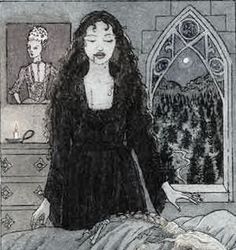
Hey ghouls!
I thought that making a non-introductory post would help solidify what I got goin here.
I think that the first things that I want to cover are my definitions, values and other miscellaneous junk, so that my coming posts are more cohesive. I do not claim to be someone who knows everything or makes the "rules of goth", I just form my opinions and claims based on what I see. I love taking part in friendly discussion, as well as hearing critique on my ideas! I've decided to cover "What makes someone goth" today, because I think it is what defines the subculture! *This is SO long! I'll provide a TLDR at the bottom, as well as try and organize each piece of thought!
What I think makes you goth! : I think that many factors come into play within considering oneself apart of the gothic community. This may be super controversial! But please, make sure you read my argument! If you pick it apart I don't mind, but please don't throw baseless accusations at me!
There's a common argument going around places like Instagram and Tiktok, where, the only factor in consideration is "Well, Do you listen to the music?" and, I think that's a really dim view on the community as a whole . Gothic Rock, Deathrock, Darkwave, Post punk, Horrorpunk, Gothibilly, etc. are all excellent music genres, and there's such a vast range of what constitutes as "Goth Music" that I don't think someone can say that they just don't like it! But nevertheless, I don't think it is the only factor in considering oneself goth, gothic, vampiric, etc. (Holy hell, that's a ton of micro labels.)
On Literature
The gothic subculture has roots back to the 1700s, as the first gothic literature by Horace Walpole, Castle of Otranto (1765), was published (Britannica). Britannica has an excellent article about Gothic fiction and if anybody is interested, I'll link it below! Other popular fictions are Dracula by Bram Stoker, Frankenstein by Mary Shelley, and Carmilla by Sheridan Le Fanu. (Books are expensive, and I'd like to read more from the genre, but between cost and time, these are the only one's I've read.)
*The article on Castle of Otranto, however, mentions s*xual assault, so please! Take care of yourself!
Gothic fiction and literature are super duper old, and the emergence of gothic fiction, especially around the 1850s, was what I believe to be the first inklings of the gothic subculture. People's ideas are ever evolving, individually, but over lifetimes as well!
There's a very interesting book by Maisha L. Wester, called African American Gothic: Screams from Shadowed Places (2012), I have not read this book, as it costs like a 100 dollars! I did check it out from the library but was too afraid of ruining it to touch it, Haha! I did manage to find the introduction on link springer, but I don't want to pirate the book because I'd love for the author to be able to get paid for the work she's done.
According to it's introduction, African American Gothic: Screams from Shadowed Places (2012) argues that so much media surrounding racism (historical fiction, historical biography, etc) is in fact applicable to gothic media (Horror, Literature, etc), but because it depicts horrors towards black bodies, critics deem it "less scary", or "too realistic" to be considered "applicable".
*Because I haven't read African American Gothic: Screams from Shadowed Places (2012), I am unable to give full context for it!
**IT IS extremely important to include black views and opinions for what makes something gothic, I'm not sure if Wester argued for inclusion in the subculture itself, or just the literary inclusion, but the literature is EXTREMELY important to consider in foundational gothic media, and so I believe Wester's argument for inclusion is something we must all consider when discussing gothic media!
On Fashion
This is an incredibly touchy subject at the moment. I think everyone has different views on the "gothic fashion vs. goth subculture" online argument. Fashion is an expressive outlet for many in the gothic subculture, and I include makeup and clothing as apart of this.
In my opinion, it's not black and white! While I do not think our desire to look cool comes before those who work in sweatshops, plus size and disabled people deserve clothing that they like! It's no secret that plus-sized individuals have a difficult time finding clothing they can wear, and brands like Shein, Romwe, and Cider, all accommodate that. Disabled people who have difficulty leaving their homes, whether it be issues that impact their energy, mobility, or something else, also need clothing to wear! There really is no difference between wearing something gothic vs wearing something basic from these websites, and so while I appreciate the sentiment "Goths don't support fast fashion", there's no possible way to make this a monolithic idea within this specific part of the subculture.
Some people will also accuse others of being classist within this topic. I think it is SO important to remember these few things:
You do not have to be goth! You also do not have to dress gothic to be goth!
There is a set of values that comes with being apart of the subculture! This is like, one of the only necessary factors I consider for members of the subculture.
IMPORTANT! So many baby bats I see are very nervous about not looking "goth enough", and not having as big of a gothic wardrobe as other people. REMEMBER! Most gothic wardrobes are curated over long lengths of time, and anything black can be made into a goth fit!
But this isn't to say that if you are poor, that you do not deserve nice clothes, or new things! I myself have been known to commit the sin of shopping on amazon! I just wanted to put this tidbit in to encourage others to not feel the need to overconsume fast fashion to fit into the community.
All that being said, I do not think fashion alone is enough to consider yourself Goth. I've seen people create a distinction between goth and gothic, and that honestly sounds like a nice way to say poser.
In the past, if you did not listen to the music, share the values, but enjoyed the aesthetic, you were seen as a poser. This got so extreme that people began to anti-label themselves! (I believe this was circa 2000s, with the emergence of emo and scene in prominent media), People would avoid labeling themselves anything at all, There's an interview of Avril Lavigne saying that calling yourself punk is the least punk thing to do, which is now totally clowned on...
... But my point here, is that as many people online who have been alternative for a very long time, seeing another alternative person cemented a feeling of community, as shared interests and values were likely.
On Values
This is so very very long already!
Alternative subcultural values are not monolithic. Metalheads, goths, punks, emos, etc. all have different values, takes, opinions etc. Please do not ask me the difference between all of these, It'd be a super long answer, and I nor anybody actually cares about my opinion about that.
That being said, gothic values and punk values are almost one in the same. I feel that it depends on the type of goth you are, but it is not outlandish to expect every goth to be against capitalism and anti fascist.
A seemingly small portion of goths say that veganism or vegetarianism is necessary, but I really think that's extreme. Necessary veganism/vegetarianism is also anti-indigenous, classist and ableist.
* I do not want to get into a debate on veganism. It is off topic.
Something that I used to see everywhere for a main criteria, is also knowing goth history! This is very important to be able to provide context on why things are the way they are, as well as rules/regulations, as well as understanding the modern gothic movement.
^(I consider this to be Bauhaus' Bela Lugosi's Dead (1979) onward, although many consider The Doors to be the first gothic rock band, and many other influences between The Doors and Bauhaus arose as well. I'll get into this later, maybe my opinion will change after more research is concluded)
Conclusion
That was a lot! Please remember that this is just my opinion, and while i am open to pleasant conversation and critique, I wont respond to anyone unkind and inflexible, and depending on the severity, I may block you! It is not out of hate or spite, but this blog is something I consider to be a safe space, and home to one of my biggest passions.
I think that I could speak more about each topic individually, but I also go outside, and don't want to get caught up in things that do not matter.
I do want to cover history as well! Maybe Vampira, Elvira, and Etcetera!
TLDR:
IMO, The factors that would make somebody goth, are not concentrated to just taste in music! The gothic subculture is not just a music fanbase! Enjoying media such as horror literature and movies, listening to music, dressing up, expressing yourself are all large components in what make up the culture, and between being a horror fan (for ex.) vs. being a goth overlaps in so many areas!
The takeaway I hope that is received is, be open minded. Gatekeeping is necessary to keep the subculture the subculture, but I don't think that it's as rigid as many people think it is.
Song Recommendation: Stigmata Martyr
I wanted to put a Bauhaus song, but I figured since I already linked Bela Lugosi's Dead, it would be redundant. Also it's likely that SO many of anyone who sees this will already know Bauhaus.
Thank you for reading!!
-Cat (They/Them)
(Catofthenine)
#goth#bauhaus#gothgoth#goth aesthetic#gothic#bela lugosi#gothic literature#goth blog#gothcore#dracula#carmilla karnstein#music snob#snobcore#Spotify
17 notes
·
View notes
Text
Bravado on the gallows
[abridged excerpt from V.A.C. Gatrell's The Hanging Tree: Execution and the English People 1770–1868, Chapter 1.1: “Dying Bravely”, emphasis mine]

the most iconic depiction of a procession to the Tyburn gallows, with the condemned on a cart going through excited crowds: William Hogarth's The Idle 'Prentice Executed at Tyburn, from the Industry and Idleness series (1747)
In theory, a Londoner growing up in the 1780s could by 1840 have attended some four hundred execution days outside Newgate alone. If he was unimaginably diligent he could have watched 1,200 people hang (and there were such obsessives). The sanction of the gallows and the rhetoric of the death sentence were central to all relations of authority in Georgian England. But the gallows were also embedded in the collective imagination, the subject of anxiety, defence, and denial, of jokes, ballads, images, and satire, and of primal gratifications too.
Even today we take comfort from an exuberant and cheering fantasy of what public hangings were like, and hence blur the memory of what the noose really did to people. A pleasant myth shields us from the reality of the process. It is not that the myth was without basis. It is what it concealed that is in question.
Central to the fantasy is the memory of the felon’s procession to Tyburn before 1783. To surface appearances it all seems rather jolly, and in certain dark senses it was so:
As clever Tom Clinch, while the rabble was bawling,
Rode stately through Holborn, to die in his calling;
He stopped at the George for a bottle of sack,
And promised to pay for it when he came back.
– J. Swift, ‘Clever Tom Clinch going to be hanged’ (1726/7)
From Newgate prison the condemned were conveyed in open carts along Holborn, St Giles, and Tyburn Road (later Oxford Street) to the triangular gallows at the foot of the Edgware Road. The major stations in this parodic progress to Calvary were at inns like the Bowl on the corner of St Giles’ High Street, or the George in Holborn, where the condemned would be offered wine; then Tyburn itself; and then again at Surgeon’s Hall at the Old Bailey, where murderers’ bodies were displayed and dissected.
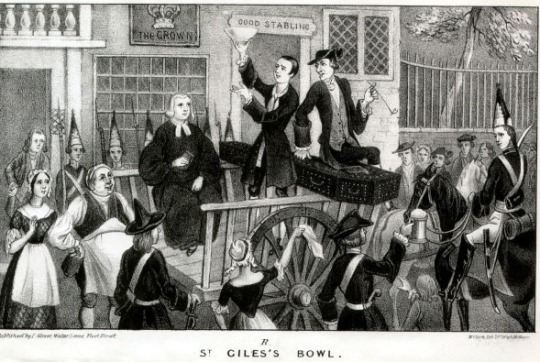
Thief, escape artist, and folk hero Jack Sheppard taking his last drink at St Giles
Playing as best they could to the crowd’s admiration and engaging in parodic dialogue with it, some felons on their way to their doom constructed the illusion that they were the masters of the ceremonies, and not the City marshal, under-sheriff, priest, constables, and javelin-men who were meant to impart solemnity and security to the procession. Lord Ferrers’s composure on his journey to Tyburn in 1760 ‘shamed heroes’, Horace Walpole reported. Hanged for murdering his servant, he bore the procession ‘with as much tranquillity as if he was only going to his own burial, not to his own execution’. Plebeians also put on fine displays:
The vilest rogues, and most despicable villains, may own a thousand crimes, and often brag of the most abominable actions; but there is scarce one, who will confess that he has no courage... The further a man is removed from repentance, nay, the more void he seems to be of all religion, and the less concern he discovers for futurity, the more he is admired by our sprightly people.
– B. Mandeville, An enquiry into the causes of the frequent executions at Tyburn (1725)
When Lewis Avershaw was hanged on Kennington Common in 1795 he appeared ‘entirely unconcerned, had a flower in his mouth, his bosom was thrown open, and he kept up an incessant conversation with the persons who rode beside the cart, laughing and nodding to acquaintances in the crowd’. He was afterwards hanged in chains on Wimbledon Common, and ‘for several months, thousands of the London populace passed their Sundays near the spot, as if consecrated by the remains of a hero’. ‘Sixteen-string’ John Rann in 1774 wore a peagreen coat, a nosegay in his buttonhole, and nankeen small-clothes tied at each knee with sixteen strings. At the gallows he sustained the demeanour of his last dinner-party in Newgate, where the company had included seven of his girls and ‘all were remarkably cheerful’. Thanks to the crowds and the convivial exchanges en route, a popular daredevil like this might take two hours to travel the couple of miles to his Tyburn death.

The Newgate Drop in action, 1809
Nor did this festive tradition die when the scaffold was removed to Newgate’s exterior in 1783. At Holloway’s and Haggerty’s hanging in 1807 both men ‘conducted themselves with the most decided indifference’. Holloway ‘with an affected cheerfulness of countenance... jumped upon the scaffold when he had ascended the ladder, his arms being pinioned with a rope behind... got his hat between his two hands, and as well as he was able, bowed to the crowd repeatedly... with a view to show that he died game, as it is expressed.’ He announced his innocence, refused to pray, and told Haggerty to ignore the clergy-man. Ascending the Newgate scaffold in 1829, Thomas Birmingham ‘was instantly greeted by a vast number of girls of dissolute character in the mob, who called out repeatedly—“Good bye, Tom! God bless you, my trump!” In the 1830s the ballad of the condemned Sam Hall conveyed the tone of these scaffold exchanges:
I saw Nellie in the crowd,
And I hollered,—right out loud—
‘Say Nellie, ain’t you proud—
Damn your eyes’ .
These mocking postures were mainly metropolitan but not exclusively so. Before his execution at York in 1739, Dick Turpin employed five mourners to follow his cart to the scaffold.
Self-parody and the display of courage was one way of dealing with terror. Defiance was another. An agricultural worker executed in Kent for arson during the Swing disturbances in 1830 declared his innocence to the last and ‘refused to pull the cap down over his eyes, saying he wished to see the people’ as he died. Others spurned God and his priests. When the highway robber Norton died game in 1827 he refused religious consolations. When a schoolmaster in Newgate sought to persuade a condemned man that there was a future life, the reply got to the truth of it: “Why you too gammon on as well as the parson! They take your life away, and then they think to make amends by telling you of another and a better world; for my part I am very well satisfied with this, if they will let me stay in it.’

Thomas Rowlandson, Malefactors on Their Way to Tyburn (c. 1776–1827)
Then there was the determined care about dress. Best clothing was worn by those who could afford it. Few men now dressed as Lord Ferrers had in 1760, in his wedding suit of white and silver, or paraded symbols like the white cockade the burglar Waistcott wore in his hat in 1759 ‘as an emblem of his whole innocence’. Male dress was becoming sober. Hatfield wore a black jacket with waistcoat, fustian pantaloons, and white cotton stockings; Fauntleroy ‘a new suit of black, silk stockings of the same colour, and light pumps’. But women continued to affect sartorial gaiety. Elizabeth Fry found that the ‘chief thought’ of nearly every condemned woman in Newgate ‘relates to her appearance on the scaffold, the dress in which she shall be hanged’. When Christian Bowman was hanged and burnt outside Newgate in 1789 she was ‘drest in a clean striped gown, a white ribbon, and a black ribbon round her cap’. In 1815 Eliza Fenning wore the dress she was to have worn for her wedding, a ‘white muslin gown, a handsome worked cap, and laced boots’.
Striking in all this is the victim’s effort to maintain dignity to the last and to die well, by drawing on a supportive vein of cynicism which ran deep in popular culture. Also striking is the authorities’ tolerance of these efforts. Those with money could spend their last days in Newgate in dissipation, as John Rann did, along with the highwayman Paul Lewis in 1763 when he entertained guests in the condemned cell by singing bawdy songs and vilifying the parson. On the scaffold likewise, custom had long entitled the condemned to address the crowd as they pleased, seditiously if they chose. Although every effort was made to force them to public professions of guilt and penitence, they were not checked if they betrayed that role. Jacobites had betrayed the role spectacularly, some making seditious speeches ‘plainly calculated’, as Dudley Ryder had observed, ‘for nothing else but to incense the people against the government... A rogue cannot be hanged but he must become a saint upon the gibbet.’

Dr Johnson lamented the abolition of the Tyburn procession: ‘the old method was most satisfactory to all parties; the publick was gratified by a procession; the criminal was supported by it. Why is all this to be swept away?’ This comment is usually taken to indicate bluff Augustan heartlessness. But its key word was ‘support’, and the generosity of Johnson’s observation is clarified in Adam Smith’s amplification of it:
A brave man is not rendered contemptible by being brought to the scaffold. The sympathy of the spectators supports him, and saves him from that shame, that consciousness that his misery is felt by himself only, which is of all sentiments the most insupportable... He has no suspicion that his situation is the object of contempt or derision to any body, and he can, with propriety, assume the air, not only of perfect serenity, but of triumph and exultation.
Johnson’s and Smith’s insights take us at last beyond the jolly surface of these rituals to the bleaker truth which social memory has censored—that most felons went to their deaths in quaking terror. In this light the abolition of the procession and the long shift towards the privatization of execution, commonly understood as a progressive and humane movement, was the reverse of that. To kill felons without ceremony and in private was to deny them the only worldly support they could hope for in their last hours. As evangelicals had their cool say on the best chances of bringing the felon to penitence, the felon was to be left alone with his death, that his spirit might break. [n.b. The author does have a point here (it’s truly horrible to die all alone, without an audience and without your loved ones, at the hands of cops, priests and bureaucrats), but this take ignores that the crowd’s support was not a given; for some they cheered, but for others they cursed, heckled, mocked, threw mud etc]
While public executions lasted, many knew that outward bravado did not speak for a felt reality, and that the powdered wig, Holland shirt, gloves, and nosegays which some flaunted on their last journey was the only resort they had to ‘meliorate the terrible thoughts of the meagre tyrant Death’. The man who did contrive to conduct himself bravely was often actually drunk out of his mind:
But valor the stronger grows,
The stronger liquor we're drinking,
And how can we feel our woes,
When we've lost the trouble of thinking?
— V.A.C. Gatrell, The Hanging Tree: Execution and the English People 1770–1868 (Oxford University Press, 1994)
#V.A.C. Gatrell#theory#swinging from the gallows tree#The Hanging Tree: Execution and the English People 1770–1868#the potatoes of defiance#england#london#I love it when I abridge excerpts#and they're still 17 screens long
35 notes
·
View notes
Photo

The Brown Lady of Raynham Hall
In 1936 Captain Hubert C. Provand was taking photos of the picturesque Raynham Hall, a country house in Norfolk, England, when he snapped this picture.
As Provand was setting up the shot, his assistant called out for the photo to be taken ‘now’, as something was descending the staircase. The result is this world famous ghost photo, said to be that of Lady Dorothy Walpole.
September 19, 1936: Photographer, Captain Hubert C Provand and his assistant, Indre Shira were taking pictures of Raynham Hall, Norfolk, England for the December issue of ‘Country Life’ Magazine.
Little did they know that on this day they would capture the ghost that has said to be haunting the old country house since the mid 1800’s.
The ghost is better known as the ‘Brown Lady’, as the spectre has been described as wearing a brown silk brocade dress.
It is believed that the Brown Lady is the spirit of Lady Dorothy Walpole, who died at Raynham Hall in 1726 from Smallpox, after a long incarceration within the houses walls.

Dorothy Walpole was the sister of Sir Robert Walpole, who was considered to be the first Prime Minister of Great Britain (serving 1721 to 1742 which would also make him the longest serving Prime Minister). Dorothy was Charles Townsend’s second wife, Charles having served as the secretary of state for ten years.
It is said that Dorothy had an affair with the 1st Duke of Wharton, Philip Wharton (yes all these upper class families make for quite complex reading and research), and her husband, Sir Walpole did not take too kindly to that, and had Dorothy locked in the upper floor rooms of their home – Raynham Hall.
Another story states that Dorothy was entrapped by the Countess of Wharton, never to leave the house… not even to see her children. It is said she returns to find, and finally be reunited with her children. A sad tale indeed!
Either way Lady Dorothy Walpole died of Smallpox 29th March 1726 aged forty.
The Brown Lady aka (possibly) Lady Dorothy Walpole has been seen on a number of occasions since her death, with the first recorded sighting being in 1835 after a Christmas party. Several guests had seen the ghost as they went up to their bedrooms for the evening, one describing it as having a glowing face but with empty eye sockets.
Captain Marryat (a gentleman who wrote novels set out at sea) retired to his room one night, and had remarked to two others he met on the way that he was carrying a gun as protection against the Brown Lady. It was at this point the apparition appeared and ‘diabolically’ grinned at the captain as she passed by him.
The captain took two shots, both passing straight through the apparition, to embed in the door and door frame beyond.

Many other people have witnessed the Brown Lady on the main staircase and in the bedrooms. Generally these sightings occur when heading to bed, or waking up in the middle of the night to find her standing in their rooms.
The ghost has also been seen right before tragic events and deaths that affect the Townsend Family. One evening, during a dinner party, many guests had seen the apparition, complete with her brown dress, walking through the crowd. The Spectre did not seem to recognize anyone and soon disappeared. The next morning, news of the death of George Walpole reached the group at the estate, George had died at about the same time the Brown Lady has been seen.
On the fateful day the photo was taken, Captain Hubert C Provand and his assistant Indre Shira had set up the camera at the foot of the main staircase, with Provand under the protective cloth at the back of the camera. They had already taken one photo and Provand was re framing for another shot. Shira suddenly called out to Provand to take another shot and at this Provand removed the lens cover and made the exposure.
Shira had seen the figure of a lady descend the staircase when he called for the photo to be taken. Upon development, the image did indeed show a spectral figure on the staircase; The Brown Lady had been captured at last!
The picture was published in Country Life magazine December 16th 1936, along with the accounts of Provand and Shira.
Renowned paranormal investigator Harry Price interviewed the two men and stated he could not find a flaw in their story, as the negative also showed the figure. With the exception of the two men lying, he could not see how the image could be anything but that of the ghost in question.
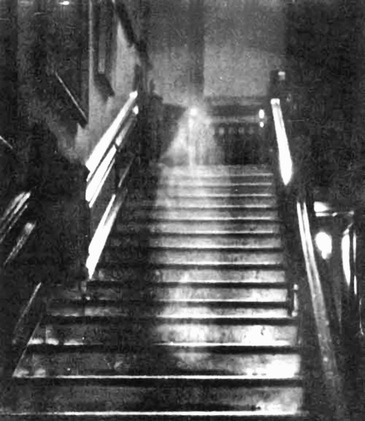
#The Brown Lady of Raynham Hall#the brown lady#Raynham Hall#Haunted Location#paranormal#ghost photo#ghost#hauntings#spirits#ghost and hauntings#ghost and spirits#haunted salem#myhauntedsalem
27 notes
·
View notes
Text
James Beattie’s essay “On Fable and Romance” in Dissertations Moral and Political (1783) is a strange hotchpotch of derivative ideas (mainly Hurd’s) but also shows the impact that the success of modern romance was having on the thinking of critics. He repeats the common view of Don Quixote as a romance-buster: “This work no sooner appeared, than chivalry vanished, as snow melts before the sun. Mankind awoke as from a dream” (Beattie in Clery and Miles, Gothic Documents, p. 92). But his account of chivalric romance sounds just like the “Gothic stories” of Walpole and Reeve, with castles in an eternal state of delapidation, complete with winding passages, secret haunted chambers, and creaking hinges, and narratives revolving around tyranny, rapine, and the ravishing of maidens. In other words, literary history had become infected with present-day fantasy. The revival of romance seems to have encouraged Beattie to apply the term freely, as Walpole did, to every kind of modern fiction including the works of Richardson and Fielding. This, however, does not save the genre from a final unexpected condemnation: “Let not the usefulness of Romance-writing be estimated by the length of my discourse upon it. Romances are a dangerous recreation . . . and tend to corrupt the heart, and stimulate the passions.”
E. J. Clery, The genesis of “Gothic” fiction
#currently reading#this rules. sorry. anyone in this thread doing a dangerous recreation that corrupts the heart and stimulates the passions
30 notes
·
View notes
Text
A Word From A Bird

PEL. A Word From A Bird. (London, United Kingdom.) Acrylic.
Sound Effect of birdsong from Pixabay.
Now here is a little and large poem
Which we hope, in our hearts will find a home.
And if we love it and give it our blessing,
It will have the freedom, to roam and roam.
Now, to bring it to life, with colour and sound,
We found, it's meant to be read or sung aloud.
For strange to us, as it may seem,
We may get the feeling, we're talking to a crowd.
We may get the feeling, we are talking to the unseen.
For it carries its own hidden music and rhyme,
Which seems to get better and louder in time.
And as we know, we all like good news,
Because good news creates more good news.
So we have taken care, to use kind and thoughtful words.
We listened to our trees and we listened to our birds.
We listened to the Oceans and to the free herds.
We listened to the Fire, burning brightly.
We listened to the Wind, blowing lightly.
We listened to the Earth, day after day
And here's what they, all have to say.
"Let's forgive the mistakes of the past
And stop worrying about the future,
For the die has been cast.
Just live in the present, to see what it brings.
For the times that are coming, will show us,
Some amazing new things."
But first a big thank you for the paper,
That carries this poem.
For we must remind ourselves please,
Who really pays without a murmur or a moan.
It is not you or me,
Nor the birds nor the fish in the seas,
But rather, our courageous and caring, terrific trees.
Though we give it little thought, our trees pay the price,
Every single day, so let's be nice.
Let's give them in this poem, one free page,
For our fast oncoming Magical New Age.
To listen to them, to let them have their say.
And though much of our World
Is in such a big and scary shamble.
It only takes one with courage,
To take a little gamble.
To believe the trees;
To listen to the breeze within the leaves.
And if we believe, their simple little message in this.
We may find our life in time, could become just bliss.
We may find, we might even fly like a bird.
After all, it's only one colour, one note, one word.
So why not try it. Test it out.
We have nothing to lose, except our pain,
And if we don't like it, we can throw it back out,
Until we're ready, until it comes around again.
So now it's time, to clean up the Planet.
Come on John, it's up to you and Janet.
Let's start right now and begin to plan it.
There's no time to wait for the rest.
First we're going to end starvation,
Then it's more conservation, re-forestation and preservation
And that's just one solution.
We’re so fed up with our own pollution.
It's time for our gentle revolution.
So come on, it's up to us, let's do our best.
And when we decide just to, let go our Hell,
For those that have fallen, for those that fell.
And when we decide to let go our fear and sorrow,
To create for our children, a safe and happy tomorrow.
And when, to our frightened and excited surprise,
We begin at last to slowly realise,
That sometimes, we are the Devil in disguise
And sometimes, we are as bright as Angel's eyes.
Then we can help us all, let go the war,
As we learn and grow and have some fun,
Like we know we did, many times before.
After all most of us, are in the dark, travelling blind,
Searching for that spark, which one day, we're bound to find,
Waiting for our children, to discover their own happy pilgrim.
So attention Trees. Stand at ease
God's Grace. Our Grace
Hurray, thank you.
Now we've had our say.
And with no further ado,
Here's our little Fairy Story,
For us and for you.
PEL

PEL. Walpole Park. (London, United Kingdom.) Acrylic.
4 notes
·
View notes